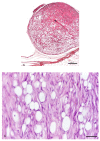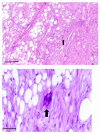Histological and Ultrastructural Description of Benign Adipocytic Tumors in Farmed Striped Sea Bream (Lythognathus mormyrus)
- PMID: 34944190
- PMCID: PMC8698149
- DOI: 10.3390/ani11123413
Histological and Ultrastructural Description of Benign Adipocytic Tumors in Farmed Striped Sea Bream (Lythognathus mormyrus)
Abstract
Cutaneous neoplasms affecting wild striped bream (Lythognathus mormyrus) have been recorded after their introduction in a marine aquaculture farm in the Adriatic Sea. The tumors were evident on 24% of the reared fish, showing single or multiple nodules, with a diameter ranging between 0.5-4.0 cm. Histologically, all the neoplastic lesions were located in the stratum spongiosum of the dermis and were surrounded by a thin capsule of connective tissue. The tumors were predominantly composed of adipocytes grouped and surrounded by a thin net of fibroblasts and collagen fibers. In some lipomas a mixture of adipocytes and uniform spindle cells were also observed. Fibroblasts and collagen fibers, or spindle cells, showing few mitotic figures were mainly observed in other nodules. Three of the tumors showed bands of cells with elongated nuclei. Five neoplasms differed from the classic spindle cell lipoma due to the presence of scattered giant cells. These cells presented acidophilic abundant cytoplasm with multiple hyperchromatic nuclei showing a concentric "floret-like" arrangement. The tumors were further characterized by ultrastructural observations that allowed ruling out the presence of virus-like particles within the lesions. Histological features of the masses lead to the identification of four prevalent patterns of neoplasms: lipoma, fibrolipoma, spindle cell lipoma (SCL), and atypical spindle cell-like lipoma (ASCL). The different neoplasms could arise from the transformation of mesenchymal cells of dermal origin. To the author's knowledge, this is the first report describing key differential histological and ultrastructural features of these neoplasms in striped sea bream.
Keywords: atypical spindle cell-like lipoma; fibrolipoma; lipoma; spindle cell lipoma; striped sea bream; tumors.
Conflict of interest statement
The authors declare no conflict of interest.
Figures







References
-
- Roberts R.J., editor. Fish Pathology. 4th ed. WB Saunders Co; London, UK: 2012. Neoplasia of teleosts; pp. 167–185.
-
- Romano L.A., Pedrosa V.F. Neoplasias in Fish: Review of the Last 20 Years. A Look from the Pathology. Annu. Res. Rev. Biol. 2020;35:134–153. doi: 10.9734/arrb/2020/v35i1230319. - DOI
-
- Hendrick M.J., Mahaffey E.A., Moore F.M., Vos J.H., Walder E.J. Histological Classification of Mesenchymal Tumors of Skin and Soft Tissues of Domestic Animals. Volume 2 Armed Forces Institute of Pathology; Washington, DC, USA: 1998. (2nd Series).
-
- Hendrick M.J. Mesenchymal Tumors of the Skin and Soft Tissues. In: Meuten D.J., editor. Tumors in Domestic Animals. 5th ed. Iowa State Press; Ames, IA, USA: 2016. pp. 142–165.
LinkOut - more resources
Full Text Sources
Research Materials
Miscellaneous

